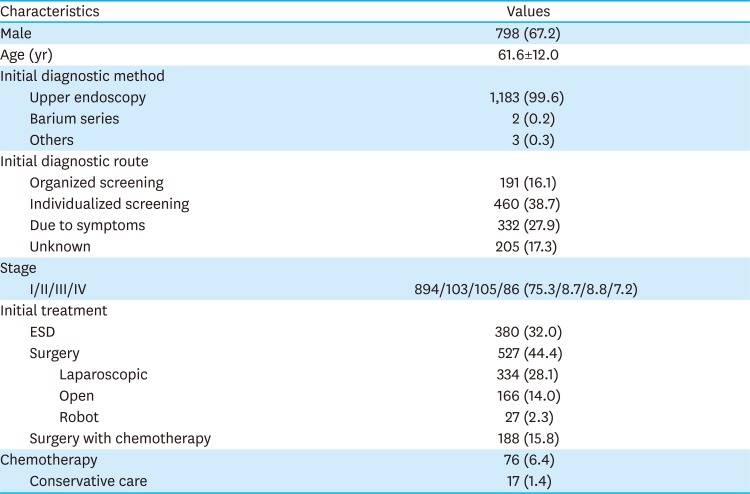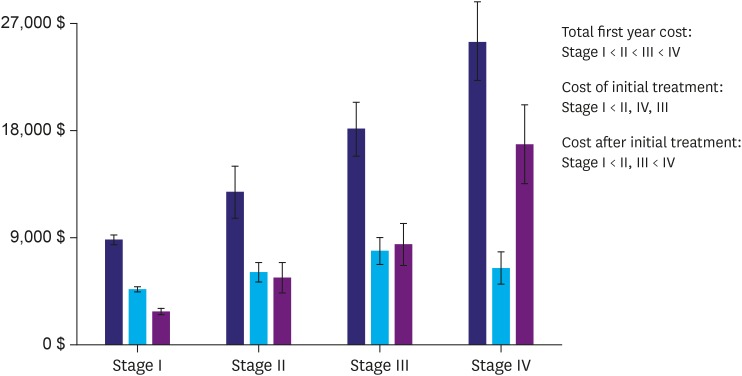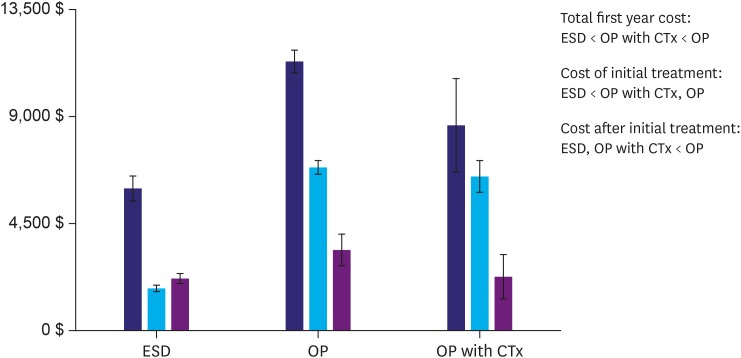1. Goto O, Fujishiro M, Kodashima S, Ono S, Omata M. Outcomes of endoscopic submucosal dissection for early gastric cancer with special reference to validation for curability criteria. Endoscopy. 2009; 41:118–122. PMID:
19214889.

2. Peppercorn J. The financial burden of cancer care: do patients in the US know what to expect? Expert Rev Pharmacoecon Outcomes Res. 2014; 14:835–842. PMID:
25269513.

3. Guy GP Jr, Ekwueme DU, Yabroff KR, Dowling EC, Li C, Rodriguez JL, et al. Economic burden of cancer survivorship among adults in the United States. J Clin Oncol. 2013; 31:3749–3757. PMID:
24043731.

4. Haga K, Matsumoto K, Kitazawa T, Seto K, Fujita S, Hasegawa T. Cost of illness of the stomach cancer in Japan - a time trend and future projections. BMC Health Serv Res. 2013; 13:283. PMID:
23879739.

5. Baker MS, Kessler LG, Urban N, Smucker RC. Estimating the treatment costs of breast and lung cancer. Med Care. 1991; 29:40–49. PMID:
1986176.

6. Li TY, Hsieh JS, Lee KT, Hou MF, Wu CL, Kao HY, et al. Cost trend analysis of initial cancer treatment in Taiwan. PLoS One. 2014; 9:e108432. PMID:
25279947.

7. Stump TK, Eghan N, Egleston BL, Hamilton O, Pirollo M, Schwartz JS, et al. Cost concerns of patients with cancer. J Oncol Pract. 2013; 9:251–257. PMID:
23943901.

8. Dinan MA, Robinson TJ, Zagar TM, Scales CD Jr, Curtis LH, Reed SD, et al. Changes in initial treatment for prostate cancer among Medicare beneficiaries, 1999–2007. Int J Radiat Oncol Biol Phys. 2012; 82:e781–e786. PMID:
22331001.

9. Kim SG, Hahm MI, Choi KS, Seung NY, Shin HR, Park EC. The economic burden of cancer in Korea in 2002. Eur J Cancer Care (Engl). 2008; 17:136–144. PMID:
18302650.

10. Jung KW, Won YJ, Kong HJ, Oh CM, Lee DH, Lee JS. Prediction of cancer incidence and mortality in Korea, 2014. Cancer Res Treat. 2014; 46:124–130. PMID:
24851103.

11. Kim SY, Kim SG, Park JH, Park EC. Costs of initial cancer care and its affecting factors. J Prev Med Public Health. 2009; 42:243–250. PMID:
19675401.

12. Veenstra CM, Regenbogen SE, Hawley ST, Griggs JJ, Banerjee M, Kato I, et al. A composite measure of personal financial burden among patients with stage III colorectal cancer. Med Care. 2014; 52:957–962. PMID:
25304021.

13. Macalindong SS, Kim KH, Nam BH, Ryu KW, Kubo N, Kim JY, et al. Effect of total number of harvested lymph nodes on survival outcomes after curative resection for gastric adenocarcinoma: findings from an eastern high-volume gastric cancer center. BMC Cancer. 2018; 18:73. PMID:
29329569.

14. Kim SG, Seo HS, Lee HH, Song KY, Park CH. Comparison of the differences in survival rates between the 7th and 8th editions of the AJCC TNM staging system for gastric adenocarcinoma: a single-institution study of 5,507 patients in Korea. J Gastric Cancer. 2017; 17:212–219. PMID:
28970951.

15. Warren JL, Yabroff KR, Meekins A, Topor M, Lamont EB, Brown ML. Evaluation of trends in the cost of initial cancer treatment. J Natl Cancer Inst. 2008; 100:888–897. PMID:
18544740.

16. Ekwueme DU, Yabroff KR, Guy GP Jr, Banegas MP, de Moor JS, Li C, et al. Medical costs and productivity losses of cancer survivors--United States, 2008–2011. MMWR Morb Mortal Wkly Rep. 2014; 63:505–510. PMID:
24918485.
17. Guy GP Jr, Yabroff KR, Ekwueme DU, Smith AW, Dowling EC, Rechis R, et al. Estimating the health and economic burden of cancer among those diagnosed as adolescents and young adults. Health Aff (Millwood). 2014; 33:1024–1031. PMID:
24889952.

18. Dowling EC, Chawla N, Forsythe LP, de Moor J, McNeel T, Rozjabek HM, et al. Lost productivity and burden of illness in cancer survivors with and without other chronic conditions. Cancer. 2013; 119:3393–3401. PMID:
23794146.











 PDF
PDF ePub
ePub Citation
Citation Print
Print



 XML Download
XML Download